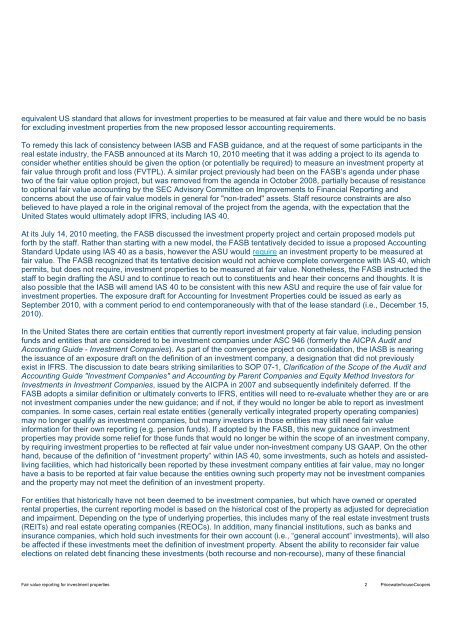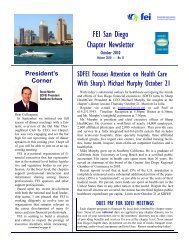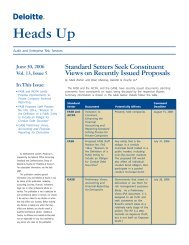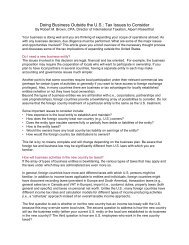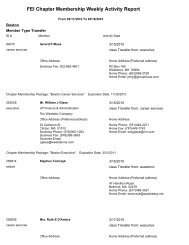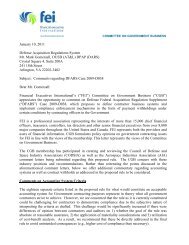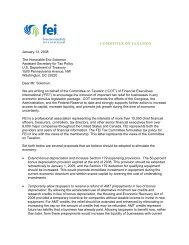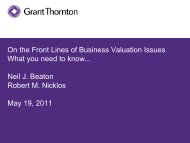Fair value reporting for investment properties under US GAAP
Fair value reporting for investment properties under US GAAP
Fair value reporting for investment properties under US GAAP
Create successful ePaper yourself
Turn your PDF publications into a flip-book with our unique Google optimized e-Paper software.
equivalent <strong>US</strong> standard that allows <strong>for</strong> <strong>investment</strong> <strong>properties</strong> to be measured at fair <strong>value</strong> and there would be no basis<br />
<strong>for</strong> excluding <strong>investment</strong> <strong>properties</strong> from the new proposed lessor accounting requirements.<br />
To remedy this lack of consistency between IASB and FASB guidance, and at the request of some participants in the<br />
real estate industry, the FASB announced at its March 10, 2010 meeting that it was adding a project to its agenda to<br />
consider whether entities should be given the option (or potentially be required) to measure an <strong>investment</strong> property at<br />
fair <strong>value</strong> through profit and loss (FVTPL). A similar project previously had been on the FASB’s agenda <strong>under</strong> phase<br />
two of the fair <strong>value</strong> option project, but was removed from the agenda in October 2008, partially because of resistance<br />
to optional fair <strong>value</strong> accounting by the SEC Advisory Committee on Improvements to Financial Reporting and<br />
concerns about the use of fair <strong>value</strong> models in general <strong>for</strong> "non-traded" assets. Staff resource constraints are also<br />
believed to have played a role in the original removal of the project from the agenda, with the expectation that the<br />
United States would ultimately adopt IFRS, including IAS 40.<br />
At its July 14, 2010 meeting, the FASB discussed the <strong>investment</strong> property project and certain proposed models put<br />
<strong>for</strong>th by the staff. Rather than starting with a new model, the FASB tentatively decided to issue a proposed Accounting<br />
Standard Update using IAS 40 as a basis, however the ASU would require an <strong>investment</strong> property to be measured at<br />
fair <strong>value</strong>. The FASB recognized that its tentative decision would not achieve complete convergence with IAS 40, which<br />
permits, but does not require, <strong>investment</strong> <strong>properties</strong> to be measured at fair <strong>value</strong>. Nonetheless, the FASB instructed the<br />
staff to begin drafting the ASU and to continue to reach out to constituents and hear their concerns and thoughts. It is<br />
also possible that the IASB will amend IAS 40 to be consistent with this new ASU and require the use of fair <strong>value</strong> <strong>for</strong><br />
<strong>investment</strong> <strong>properties</strong>. The exposure draft <strong>for</strong> Accounting <strong>for</strong> Investment Properties could be issued as early as<br />
September 2010, with a comment period to end contemporaneously with that of the lease standard (i.e., December 15,<br />
2010).<br />
In the United States there are certain entities that currently report <strong>investment</strong> property at fair <strong>value</strong>, including pension<br />
funds and entities that are considered to be <strong>investment</strong> companies <strong>under</strong> ASC 946 (<strong>for</strong>merly the AICPA Audit and<br />
Accounting Guide - Investment Companies). As part of the convergence project on consolidation, the IASB is nearing<br />
the issuance of an exposure draft on the definition of an <strong>investment</strong> company, a designation that did not previously<br />
exist in IFRS. The discussion to date bears striking similarities to SOP 07-1, Clarification of the Scope of the Audit and<br />
Accounting Guide "Investment Companies" and Accounting by Parent Companies and Equity Method Investors <strong>for</strong><br />
Investments in Investment Companies, issued by the AICPA in 2007 and subsequently indefinitely deferred. If the<br />
FASB adopts a similar definition or ultimately converts to IFRS, entities will need to re-evaluate whether they are or are<br />
not <strong>investment</strong> companies <strong>under</strong> the new guidance; and if not, if they would no longer be able to report as <strong>investment</strong><br />
companies. In some cases, certain real estate entities (generally vertically integrated property operating companies)<br />
may no longer qualify as <strong>investment</strong> companies, but many investors in those entities may still need fair <strong>value</strong><br />
in<strong>for</strong>mation <strong>for</strong> their own <strong>reporting</strong> (e.g. pension funds). If adopted by the FASB, this new guidance on <strong>investment</strong><br />
<strong>properties</strong> may provide some relief <strong>for</strong> those funds that would no longer be within the scope of an <strong>investment</strong> company,<br />
by requiring <strong>investment</strong> <strong>properties</strong> to be reflected at fair <strong>value</strong> <strong>under</strong> non-<strong>investment</strong> company <strong>US</strong> <strong>GAAP</strong>. On the other<br />
hand, because of the definition of “<strong>investment</strong> property” within IAS 40, some <strong>investment</strong>s, such as hotels and assistedliving<br />
facilities, which had historically been reported by these <strong>investment</strong> company entities at fair <strong>value</strong>, may no longer<br />
have a basis to be reported at fair <strong>value</strong> because the entities owning such property may not be <strong>investment</strong> companies<br />
and the property may not meet the definition of an <strong>investment</strong> property.<br />
For entities that historically have not been deemed to be <strong>investment</strong> companies, but which have owned or operated<br />
rental <strong>properties</strong>, the current <strong>reporting</strong> model is based on the historical cost of the property as adjusted <strong>for</strong> depreciation<br />
and impairment. Depending on the type of <strong>under</strong>lying <strong>properties</strong>, this includes many of the real estate <strong>investment</strong> trusts<br />
(REITs) and real estate operating companies (REOCs). In addition, many financial institutions, such as banks and<br />
insurance companies, which hold such <strong>investment</strong>s <strong>for</strong> their own account (i.e., “general account” <strong>investment</strong>s), will also<br />
be affected if these <strong>investment</strong>s meet the definition of <strong>investment</strong> property. Absent the ability to reconsider fair <strong>value</strong><br />
elections on related debt financing these <strong>investment</strong>s (both recourse and non-recourse), many of these financial<br />
<strong>Fair</strong> <strong>value</strong> <strong>reporting</strong> <strong>for</strong> <strong>investment</strong> <strong>properties</strong> 2 PricewaterhouseCoopers


